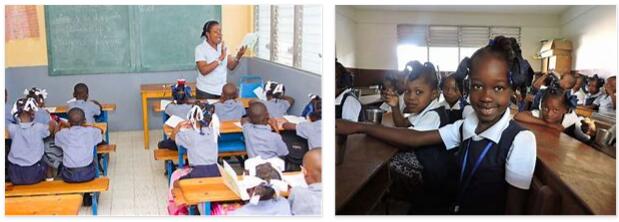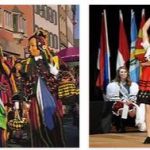Typical Haiti
Voodoo
Voodoo (spoken: Wudu) is the name of a religion that was once brought to the Caribbean by slaves from West Africa. There it is mainly practiced in Haiti. Thereby elements from the old faith mixed with those from Catholicism. Many Haitians are Catholic, but still follow the voodoo.
The god of voodoo is called Bondye (derived from Bon dieu, “good god”). Between this god and humans stand the loa, spirit beings. There are more than 200 loa that can be divided into three groups. Each loa is responsible for a specific part of life.
In ceremonies there is drumming and dancing. The dancers go into a trance, i.e. a changed state of consciousness, and, according to their belief, are possessed by a loa. Animals or food are offered to the Loa and altars are erected for them. There are priests (houngans and bocore) and priestesses (mambos). Voodoo is practiced more in the country than in the city in Haiti.
Tap-tap
Brightly painted cars and buses stand out on the streets of Haiti. They are shared taxis and they are called tap-tap. That means fast-fast. The tap taps drive on fixed routes. However, it only starts when the last seat is occupied.
Rara
When drums and bamboo horns sound and people dance and sing through the streets, then it must be rare! The festival is celebrated before Easter. It’s a mix of carnival and religion, and it’s also related to voodoo. For example, rituals for the voodoo spirits are performed at crossings and bridges.
Everyday Life
Life in Haiti
It is not easy for children who grow up in Haiti. Because Haiti is a very poor country. Many families do not have enough to eat. They live in poor huts or in the slums that continue to grow around the capital Port-au-Prince. If then droughts, floods, cyclones or earthquakes happen, the situation becomes catastrophic.
What are restavèks?
In addition to poor and malnourished children, there are also many children in Haiti who have lost their parents to earthquakes, but also to illness. Finally, the number of street children and child laborers is very high. 24 percent of children between the ages of 5 and 14 work in Haiti!
Many of these children are restavèks. The word is derived from the French rester avec. That means “staying with someone”. They are sent from home, usually in the country, to a wealthier family in the city, where they then have to work as house slaves. Some of the restavèks run away and end up being street kids. Many children also have to help in their parents’ farms and fields, or they wash cars, beg or sell something on the street.
Children and School
School in Haiti
All students in Haiti wear a school uniform. Classes are in French, but now also partly in the Haitian Creole language. This helps the first graders a lot, because in the past they often didn’t understand the lessons at all.
The first grade starts at the age of 6. Basic education comprises nine years, which are divided into three by three years. However, schooling is only compulsory up to the age of 11 – and even that is often not observed. There is an examination after the 6th grade, and also after the 9th grade. The secondary school lasts four years.
Little chance of a good education
Education in Haiti, a country located in Central America according to allcountrylist, does not have a particularly good reputation. Schools are poorly equipped, there are too many children in one class, and there is a lack of well-trained teachers. Most schools are privately run, the state only runs 20 percent of all schools. There are church schools and those that someone started to earn money. Often these schools are very poor. Nevertheless, they cost school fees. Even kindergarten costs fees – and they are often very high.
There are many people in Haiti who cannot read and write. It is 51 percent among adults and 26 to 30 percent among young people.
Destroyed schools
If many school buildings are destroyed in an earthquake like the one in 2010, the chances of education are reduced even further. Help often comes from abroad. Aid organizations then ensure that lessons can take place again. But a year after the earthquake, many schools were still closed or housed in makeshift tents.
Not everyone goes to school
A total of 83 percent of the children go to primary school. This means that 17 out of 100 children do not go to school at all. This also applies to children from slums, from remote rural areas or children who work. Only 36 percent of a year go to a secondary school. In addition, many children leave school again without graduating.
Eating in Haiti
What do you eat in Haiti?
The Haitians call breakfast dejennen. There is bread with cream cheese and jam, but also eggs and plantains. Some even eat spaghetti for breakfast!
Lunch is called dinner. Very often there are Diri ak pwa: rice with red and brown beans. It is Haiti’s national dish. For example, there can be fish or meat. Even Sos pwa can be given over the rice. It’s a sauce made from pureed beans. Macaronia casserole is also popular.
But (at every meal, especially dinner Soupe called), a maize porridge is served, it is called Mayi Moulen. Also Bonne Bouillie is a porridge, but from flour, sugar, milk and cinnamon. It is also eaten in the evening with pleasure. Delicious snacks are filled little pies.
Plantains
Haitians are very fond of plantains. The bananas are cut into slices and fried in hot oil. Then you flatten them with a wooden board and fry them again. That is then called Bannann Peze. This can be served with fried chicken, for example. A sauce shouldn’t be missing either: Sos Kreyol is made from cooked tomatoes.
What other ingredients are there?
The most beautiful tropical fruits can be harvested several times a year: pineapples, papaya, mangoes, bananas, coconuts, oranges and prickly annons are among them. They are often served as dessert at noon. People also like to drink juices made from pressed fruit. Cassava, beans in several varieties, breadfruits, pigeon peas, cabbage and sweet potatoes are other ingredients. In addition to meat, one also likes to eat fish.
Soup joumou is a must for the New Year
Haitians traditionally eat soup joumou on New Year’s Eve. That’s the country’s independence day. In the past, slaves were forbidden to eat delicacies. Pumpkin was one of them. This is the main ingredient of the soup. There are also meat, potatoes, plantains and vegetables such as carrots or cabbage. After pureeing, noodles are often added. There is also bread.









